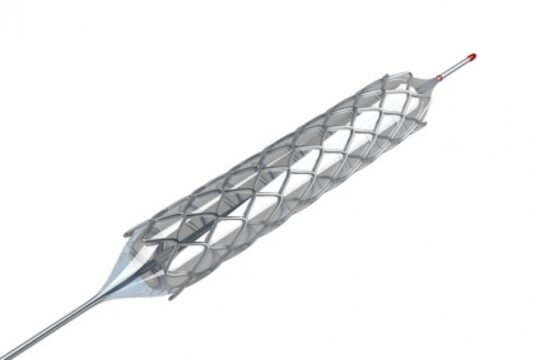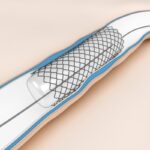Título original: Drug-Eluting Balloon in Peripheral Intervention for the Superficial Femoral Artery. The DEBATE-SFA Randomized Trial (Drug Eluting Balloon in Peripheral Intervention for Superficial Femoral Artery). Referencia: Liistro, F, el tal. J Am Coll Cardiol Intv 2013;6(12):1295-1302 El tratamiento de elección actualmente en el territorio femoropoplíteo es la angioplastia, sin embargo tiene una tasa…
La disminución del sangrado con el acceso radial le deja poco a la bivalirudina para un beneficio adicional.
Título original: Bivalirudin or heparin in primary angioplasty performed through the transradial approach: results from a multicentre registry. Referencia: Sciahbasi A et al. Eur Heart J: Acute Cardiovasc Care. Epub ahead of print. Está demostrado el beneficio de la bivalirudina en términos de sangrado, sin embargo cuando la angioplastia primaria es realizada por acceso…
El FFR cambia la estrategia de tratamiento en casi la mitad de los pacientes
Título original: Outcome impact of coronary revascularization strategy reclassification with fractional flow reserve at time of diagnostic angiography. Referencia: Van Belle E et al. Circulation. 2014 Jan 14;129(2):173-85. Aún no se había publicado un registro extenso que evaluara el impacto de la reserva fraccional de flujo coronario (FFR) paracambiarla estrategia de revascularizaciónenpacientes individuales referidos…
Mala aposición en stents farmacológicos. Mucho más frecuente y mucho menos grave de lo que creíamos.
Título original: Incidences, Predictors, and Clinical Outcomes of Acute and Late Stent Malapposition Detected by Optical Coherence Tomography After Drug-Eluting Stent Implantation Referencia: Im E. et al. CircCardiovascInterv. 2014 Jan 14. [Epubahead of print] Este trabajo analizó las imágenes por tomografía de coherencia óptica (OCT) de 351 pacientes con 356 lesionesque recibieron stents farmacológicos…
Riesgo isquémico vs riesgo anatómico. ¿Alguno es mejor para ayudarnos a decidir la terapéutica?
Título original: Predicting Outcome in the COURAGE Trial. Coronary Anatomy Versus Ischemia. Referencia: G. B. John Mancini et al. J Am Coll Cardiol Intv 2013, Article in press. El riesgo anatómico, el monto isquémico o una combinación de ambos, son factores frecuentemente tenidos en cuenta para estimar el pronóstico o elegir una estrategia de…
Stent liberador de everolimus y balón farmacológico en reestenosis de BMS. Buenos resultados de ambos con algunas diferencias esperables.
Título original: A Randomized Comparison of Drug-Eluting Balloon Versus Everolimus-Eluting Stent in Patients With Bare-Metal Stent In-Stent Restenosis: The RIBS V Clinical Trial. Referencia: Fernando Alfonso et al. J Am Coll Cardiol. 2014; Epub ahead of print. Los stents farmacológicos (DES) han demostrado ser superiores en términos de reestenosis a los stents convencionales (BMS),…
El registro con seguimiento más largo en angioplastia al tronco de coronaria izquierda. Diferencias significativas según el segmento enfermo.
Título original: Long Term Clinical Outcomes After Percutaneous Coronary Intervention for Ostial/Mid-Shaft Versus Distal Bifurcation in Unprotected Left Main Coronary Artery Titulo original: The DELTA Registry (Drug-Eluting Stent for Left Main Coronary Artery Disease): A Multicenter registry Evaluating Percutaneous Coronary Intervention Versus Coronary Artery Bypass Grafting for left Main Treatment Referencia: Naganuma T, et al.…
Reestenosis intrastent, el único subgrupo que se beneficia de más tiempo de doble anti agregación
Título original: Short vs. Long Term Duration of Dual Antiplatelet Therapy in Patients treated for InstentRestenosis. A PRODIGY Trial substudy. Referencia: Gianluca Campo el al. J Am CollCardiol, article in press. En el estudio PRODIGY (Prolonging Dual AntiplateletTreatmentAfterGrading Stent-Induced Intimal Hyperplasia) se observó que el régimen de 24 meses de doble anti agregación no…
Tronco no protegido en diabéticos: la angioplastia con buenos resultados a largo plazo pero con mayor revascularización.
Título original: Coronary artery bypass graft versus percutaneous coronary intervention with drug-eluting stent implantation for diabetic patients with unprotected left main coronary artery disease: D-DELTA registry. Referencia: Meliga Emanuele, et al. EuroIntervention 2013; 9:803-808 La diabetes incrementa el riesgo de eventos cardiovasculares debido a su afectación en forma difusa de los vasos, generando de esta manera, más eventos…
Stent liberador de everolimus a 3 años, la mayor seguridad fue la clave de la diferencia.
Título original: Everolimus-eluting stents in patients undergoing percutaneous coronary Intervention: Final 3-year results of the Clinical Evaluation of the XIENCE V Everolimus Eluting Coronary Stent System in the Treatment of Subjects With de Novo Native Coronary Artery Lesions trial. Referencia: Sorin J. Brener et al. Am Heart J 2013;0:1-8. El stent XIENCE (Abbott Vascular,…









